#ZapadWatch: A Closer Look at Slavic Brotherhood 2017
Analysis shows something different than claimed counterterrorism exercise
#ZapadWatch: A Closer Look at Slavic Brotherhood 2017
Share this story

From June 6 to 14, the third annual Slavic Brotherhood exercise between Russia, Belarus, and Serbia took place in Belarus. The Russian Ministry of Defense claimed the goal of the exercise was working with Belarus and Serbia to fight international terrorism.
Colonel Alexey Sgibnev, the Russian deputy commander of Slavic Brotherhood 2017, provided an official statement that the “counterterrorism” exercise included multinational battalion movement, water crossings, an airlift using Il-76 aircraft, territorial control training, and scenarios including securing facilities seized by “terrorists,” “hostage” rescue, and evacuation of “injured” troops.
Despite the rhetoric of counterterrorism, open source investigation and military analysis of the exercise provide reason for skepticism of this claim. The equipment and tactics used during the week-long exercise are more commonly associated with counterinsurgency or large-scale military conflict, as opposed to narrowly tailored counterterrorism operations.
Too big for small conflict
Evidence shows that some of the equipment used in Slavic Brotherhood 2017 does not fit the swift and precision-based approach associated with counterterrorism efforts.
For example, the BMD-2, an infantry fighting vehicle, is designed to fight large numbers of well-equipped infantry or other armored vehicles. These vehicles, which conducted range-firing exercises during Slavic Brotherhood 2017, would generally not be used in civilian areas, due to the possibility of collateral damage.
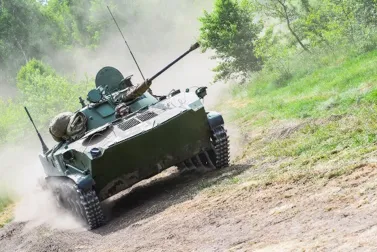
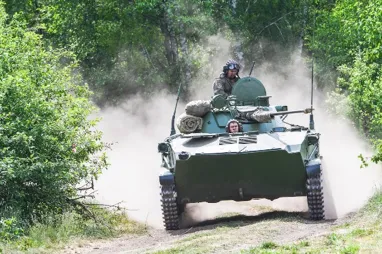
The anti-aircraft weapon ZU 23–2, mounted on a Ural 4320 truck, was also depicted in footage of the exercise. The presence of these weapons implies the presumption that terrorists will have aircraft of their own.
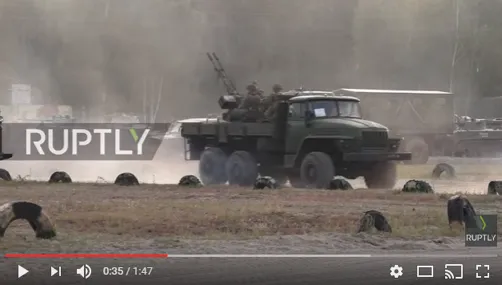

Tactical truth
A number of tactics used in the training do not fit with the nature of counterterrorism operations. The following are four examples of tactics — again — more commonly used in broader conflict.
Troop convoys are used to transport large numbers of combat-ready troops over unfriendly territory. This tactic is used to invade or defend large territories, not to counter terrorist attacks.
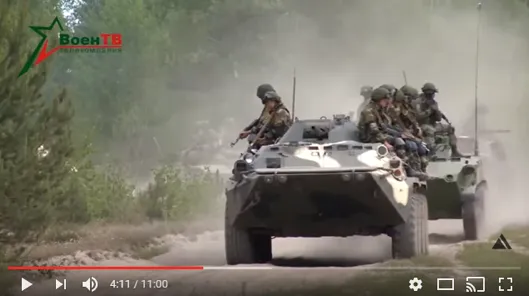
Amphibious infiltration tactics are used to cut into enemy territory and are designed to achieve a surprise effect on enemy troops. Such tactics are generally not used in friendly territory because of reduced speed and increased vulnerability. The need for a surprise attack with heavy artillery is rare in friendly territory or limited counterterrorism operations. Video footage clearly shows a large amount of machinery transported using this method during Slavic Brotherhood 2017.
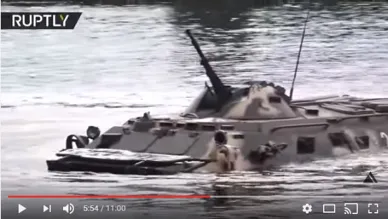

Airborne operations are used to populate forces within enemy territory. The use of such tactics during Slavic Brotherhood 2017 suggests troops participating were training for operations behind enemy lines in territories ground troops are less able to access.

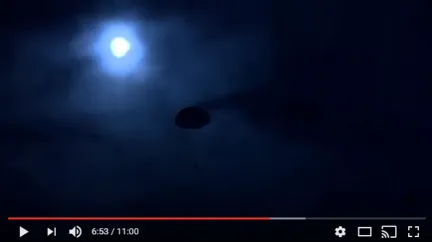
Troops in Slavic Brotherhood 2017 used a full-frontal, attack-and-support infantry approach tactic, an offensive approach that is used to overwhelm and neutralize an enemy and that gives little consideration to collateral damage. In other words, the approach assumes all-out conflict with a concentrated enemy, and thus the likelihood of collateral damage is high.

During the attack of the terrorist encampment exercise, troops were constantly suppressing the enemy with fire, while others attacked and moved closer. Notably, troops did not appear to use precision-based hostage operation tactics.
This suggests the troops approached the encampment as if it were any regular enemy military force.
Offensive Operations
The weapons and tactics used by Russian, Belarusian, and Serbian forces in the Slavic Brotherhood 2017 exercise would be more appropriate for fighting organized military forces, rather than terrorist groups. Even the opposing forces (OPFOR) participating in the exercise scenario were armed with automatic rifles, machine guns, and anti-tank weapons — suggesting the OPFOR may have been imitating a foreign military force.
No clear signs of special operations forces or hostage rescue operations were found from the open source material available on the exercise. The bulk of the training force came from the airborne branches of each military — the 76th or 104th Airborne Assault Division associated with the Russian base in Pskov (Rus. Воздушно-десантные войска России, ВДВ), the 38th Separate Airborne Assault Brigade of Belarus’s Special Operations Forces, and Serbia’s Special Brigade. These troops are similar to the U.S. Marines, whose primary role is expeditionary — to infiltrate enemy territory and make way for conventional troops to follow. Furthermore, the tactics used by the troops at Slavic Brotherhood 2017 were offensive — as if with the purpose of infiltrating hostile territory.
Conclusion
Considering the evidence, the Slavic Brotherhood 2017 exercise seems to be a traditional military exercise rather than a counterterrorism exercise. The scenario was more suited to operations in a foreign country or a region in revolt, evoking Russia’s current operations in Syria or Ukraine. Given this context, Slavic Brotherhood 2017 was even more pronounced when considering that the training took place fewer than 10 kilometers from the border with Poland and 50 kilometers away from the border with Ukraine.
@DFRLab will continue to monitor the situation through the summer, as preparations for Zapad 2017 intensify. If you or any other #DigitalSherlocks see anything on the ground or online related to the exercises, join the conversation using #ZapadWatch.

